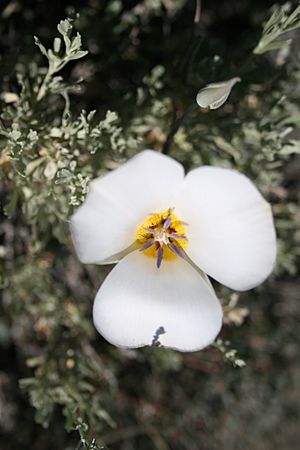Panamint mariposa lily facts for kids
Quick facts for kids Panamint mariposa lily |
|
|---|---|
 |
|
| Scientific classification | |
| Genus: |
Calochortus
|
| Species: |
panamintensis
|
| Synonyms | |
|
|
The Calochortus panamintensis, also known as the Panamint mariposa lily, is a special and rare type of flowering plant. It belongs to the lily family and grows naturally in North America. This beautiful flower gets its name from the Panamint Range of mountains, which are close to the famous Death Valley in California.
Contents
Where Does the Panamint Mariposa Lily Grow?
This unique lily is native to specific areas in the United States. You can find it mainly in Inyo and Kern Counties in California. It also grows in a nearby area called Nye County, Nevada in Nevada. Because it only grows in these few places, it is considered a rare plant.
What Does the Panamint Mariposa Lily Look Like?
The Panamint mariposa lily is a type of plant called a perennial herb. This means it lives for many years and grows back each season.
Its Stem and Leaves
The plant produces a single, straight stem that does not branch out. This stem can grow quite tall, usually between 40 to 60 centimeters (about 16 to 24 inches) high. At the bottom of the plant, there is a long leaf, about 10 to 20 centimeters (4 to 8 inches) long. This basal leaf often dries up and disappears by the time the plant flowers. You might also see some smaller leaves growing along the stem.
The Flowers
The top of the stem holds the plant's beautiful flowers. There are usually 1 to 4 flowers, and they stand upright. Each flower is shaped like a bell.
- Each flower has three sepals. These are like small, leaf-like parts that protect the flower bud. Sometimes, these sepals have dark spots near their base.
- It also has three petals, which are the colorful parts of the flower. These petals can be up to 4 centimeters (about 1.5 inches) long.
- The petals are usually white or a pale purple color.
- Look closely, and you might see a red and yellow blotch at the very bottom of each petal.
- The outside of the petals often has green stripes, adding to its unique look.
The Fruit
After the flower blooms, it produces a fruit. This fruit is a narrow capsule, which is a dry fruit that splits open to release seeds. The capsule can be about 7 centimeters (about 2.7 inches) long.
You can learn more about this plant from scientific sources like the Flora of North America.

